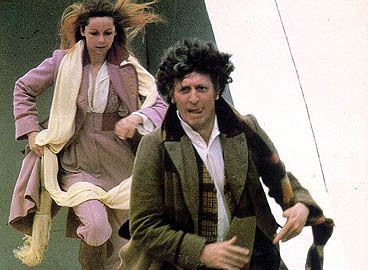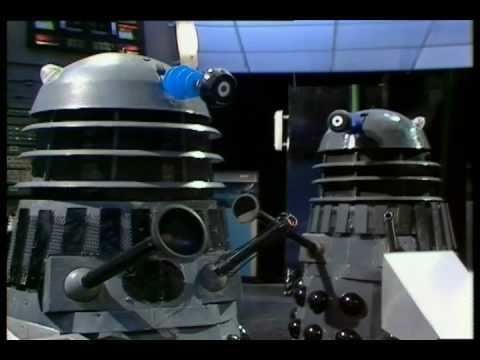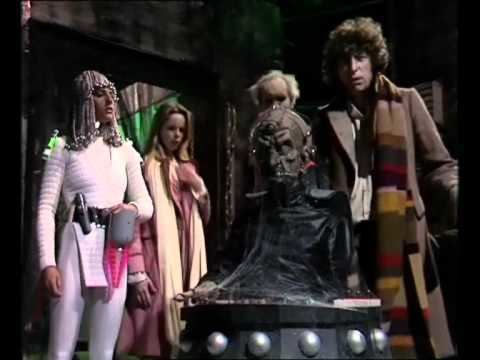7.6 /10 1 Votes
Producer Graham Williams | 7.5/10 IMDb Executive producer(s) None Production code 5J Running time 1h 39m Written by Terry Nation | |||||||||||||||||||||||||||||||||
Cast Lalla Ward, Nicholas Courtney, Carole Ann Ford, Jacqueline Hill, William Russell Similar Resurrection of the Daleks, The Masque of Mandragora, The Keeper of Traken, The Face of Evil, The Hand of Fear | ||||||||||||||||||||||||||||||||||
Doctor who review destiny of the daleks 1979
Destiny of the Daleks is the first serial of the 17th season in the British science fiction television series Doctor Who, which was first broadcast in four weekly parts from 1 September to 22 September 1979. The story introduces Lalla Ward as the newly regenerated Romana.
Contents
- Doctor who review destiny of the daleks 1979
- Doctor who destiny of the daleks romana
- Plot
- Production
- Cast notes
- Broadcast and reception
- In print
- Home media
- References

Doctor who destiny of the daleks romana
Plot

The Doctor, following the events of The Armageddon Factor, is repairing K9. Meanwhile, Romana, for reasons unknown, regenerates, eventually choosing the form of Princess Astra from the preceding adventure, in spite of the Doctor's disapproval of it, as well as several "test bodies" she tries on beforehand.

The TARDIS lands on a rocky planet, which has breathable air but dangerously high levels of radioactivity. They explore and see a group of ragged-looking humans burying one of their dead, followed by a spaceship landing and half-burying itself in the ground in a valley. Just as the Doctor and Romana are about to investigate, underground explosions force them back towards the ruins. Whilst exploring the ruins, another underground explosion occurs, trapping the Doctor. Romana returns to the TARDIS to reassemble K9 so he can assist, but she finds the TARDIS half-buried in rubble. Realising that she cannot reach K9, she goes back to find that the Doctor has vanished. As she turns to leave, a man who has been following her blocks her path. She backs away, falls down a rubble chute, and loses consciousness. She recovers only to have three Daleks burst through the wall and capture her, and command her to work at one of their drilling sites.
Meanwhile, the Doctor is thanking the white-clad, silver-haired humanoids who have rescued him, remarking on their strength. He asks their leader, Commander Sharrel, where he is, and is told that the planet is D-5-Gamma-Z-Alpha, otherwise known as Skaro. The Doctor is astonished to hear that the Movellans are here to wage war against the Daleks. Two Movellans bring in a new prisoner, the man who has been following the Doctor and Romana. He identifies himself as Starship Engineer Tyssan. He reveals that the Daleks have used him as slave labour as part of a search operation for two years. He tells the Doctor about what has happened to Romana, and they set out to rescue her.
The Doctor, Tyssan and three Movellans find Romana and head into the Dalek headquarters. The Doctor establishes that the Daleks are searching for something on a level that they have yet to access, and remembers an alternative route to this area, so they make their way to this floor. There they discover Davros, the creator of the Daleks, who was in suspended animation and now slowly comes to life.
The Doctor moves the revived Davros into a blocked-off room in the ruins of the Dalek city. The Doctor and Davros talk about the Daleks' "accomplishments" during the thousands of years he has been in suspended animation, and whilst the Doctor comments on the countless lives the Daleks have ruined, Davros replies that the Daleks have only just begun their conquest of the cosmos. The Daleks find them both, and the Doctor holds Davros hostage with a makeshift explosive he has just concocted, bargaining with the Daleks to free all their prisoners, and to let him escape. Davros makes them see that the Doctor's logic is "impaired by irrational sentiment" and the Daleks comply. The Daleks remove the explosive and Davros vows to make the Daleks invincible, and the supreme power of the universe.
Romana reaches the Movellan spaceship; but learns that the Movellans are not as altruistic as they appear when they knock her out. The Movellans test their nova device: a weapon which changes air molecules so that a planet's atmosphere becomes flammable and can be set alight, killing all life. The Doctor meets up with Tyssan and they find a female Movellan scout. The Doctor confirms his suspicion that the Movellans are actually robots, by removing the power pack on her belt and deactivating her. He finds Romana but is captured by the Movellans.
The Doctor learns that the Daleks and Movellans have been in a stalemate for over two centuries, and that both sides' battle computers have been calculating the best strategy and precise moment at which to attack. So far, not a single shot has been fired. The Daleks want Davros to help them gain an advantage. The Movellans want the Doctor to do the same for them, which the Doctor refuses to do. Davros, on the other hand, is all too eager to give the Daleks the upper hand. He orders them to make a suicide bombing attack on the Movellan craft upon realising that the Doctor might do the same thing for the Movellans. Meanwhile, Tyssan leads the prisoners in an attack on the Movellans, deactivating them all.
The Doctor makes his way to the city to confront Davros. The Doctor informs Davros that the Movellans have been disabled; unfortunately Davros does not believe him and intends to destroy the Movellan ship anyway. As the Daleks approach the ship, the Doctor goes to detonate the bombs but is ambushed by a Dalek, which holds him at gunpoint. The Doctor throws his hat on the Dalek's eyestalk, blinding it, then destroying it. He then detonates the bombs and destroys the Dalek squad before it reaches the Movellan ship.
The Doctor then puts Davros into the custody of the former slave workers. Davros is placed in cryogenic suspension and taken to Earth to stand trial for his crimes. The Doctor and Romana leave, remarking on the fact that whoever makes mistakes often wins.
Production
This was Dalek creator Terry Nation's final script for Doctor Who; he declined several further offers due to the extensive uncredited story rewrite by script editor Douglas Adams. Ken Grieve, director of the serial, claimed on the DVD commentary that Adams wrote 98% of the script. Nation moved to the United States in 1980 and would go on to work for various television projects in America, most famously as a writer and producer for MacGyver.
Michael Wisher was unavailable to reprise the role of Davros, as he was on tour in Australia. David Gooderson replaced him, but the Davros mask (which was originally fitted for Wisher) was five years old and in poor condition; as a result, it suffers in appearance. K9 only appears near the start of the story, explained in-story as due to an electronic form of laryngitis - the croaking was provided by Roy Skelton. K9's absence was because the prop was unsuitable for the large amount of location filming — the production team had suffered several problems using K9 on a similar location in The Stones of Blood, and were not keen on repeating the experience. Terry Nation has said he had no desire to use K9 in his storyline; the scene (as well as other continuity gestures to Season 16) was inserted during rewrites by Douglas Adams.
Winspit Quarry in Dorset was used for the planet Skaro, also used were the quarry's small stone cottage and two larger brick buildings, (which all stood side by side and were just empty derelict shells, with their roofs missing). The BBC added to the flooring of the two larger buildings, a large number of silver coloured cylinders and pipes, sticking out of the rubble, the cylinders transformed these two derelict shells into the external ruins of the long abandoned Dalek city and the disused Kaled bunkers.
The serial was one of the first British productions to make use of a Steadicam; due to the high cost of such a set-up, nearly all the props and sets were reused, including the Davros mask.
The instalments of this serial are credited onscreen as "episodes", rather than "parts" - the only serial made after The Green Death to do so. In the next story, City of Death, it was returned to "parts".
Cast notes
Tim Barlow, who played Tyssan, was profoundly deaf at the time of filming.
Tony Osoba later played Kracauer in the 1987 Doctor Who serial Dragonfire, and Duke in the 2014 episode Kill the Moon. David Yip later played Curly in the Doctor Who audio play The Girl Who Never Was.
Broadcast and reception
According to the BBC's Audience Research Report, the serial was received positively, especially amongst children. The Daleks and Baker were praised, though the response to Ward was more mixed. The story was repeated on BBC1 across four consecutive evenings from Tuesday to Friday, 5–8 August 1980, achieving viewing figures of 4.9, 5.8, 7.1 and 6.5 million viewers respectively.
Paul Cornell, Martin Day, and Keith Topping wrote in The Discontinuity Guide (1995) that the serial had "a tacky, inconsequential feel that comes from a decade of having its best jokes sneered at." In The Television Companion (1998), David J. Howe and Stephen James Walker criticised Romana's bizarre regeneration, the implication that the Daleks were now robots, and David Gooderson's Davros, believing the character was not only harmed by being played by a lesser actor but that he was also not as well written. Despite this, they said the story "ultimately manages to rise above all its undoubted failings and provides a fair degree of entertainment." In 2011, Mark Braxton of Radio Times wrote that the Daleks lacked menace and the script could be too comedic at times, but in spite of its flaws it was "clattering good fun". The A.V. Club reviewer Christopher Bahn praised the first episode and the introduction of the new Romana, but felt the story quickly became dull and mishandled Davros and failed to do anything with the Daleks. Ian Berriman of SFX gave Destiny of the Daleks two out of five stars, criticising the Daleks as robots and much of the comedy. He also noted that it looked "shabby".
In print
A novelisation of this serial, written by Terrance Dicks, was published by Target Books in November 1979. This was released just two months after the original transmission - one of the quickest novelisations of the Doctor Who book range, and was released before any of the previous season's stories. A German translation of the book was published by Goldmann in 1990.
Home media
Destiny of the Daleks was released on VHS in July 1994. In 2001 it was remastered and re-released as part of The Davros Collection, which consisted of VHS editions of Genesis of the Daleks, Destiny of the Daleks, Resurrection of the Daleks, Revelation of the Daleks and Remembrance of the Daleks. This story was released on DVD on 26 November 2007. It is available on its own and as part of the Davros Collection DVD box set (as listed above). This serial was also released as part of the Doctor Who DVD Files in issue 58 on 23 March 2011.
